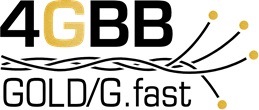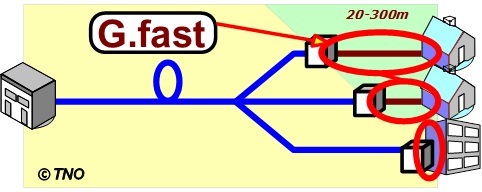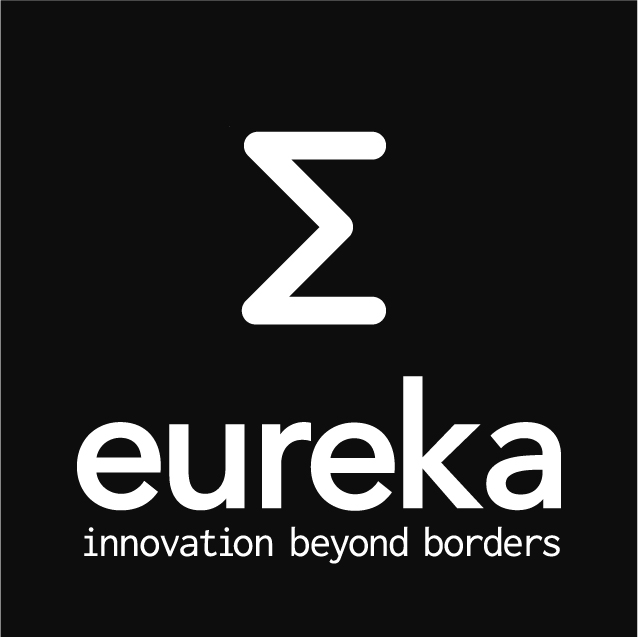Multi-gigabit access via copper
New Celtic-Plus project explores cost-effective ultra-broadband access based on G.fast standard
23 March 2015, Heidelberg, Germany. Celtic-Plus is launching a 4.4 million euro project to explore multiple-gigabit copper access based on G.fast, a digital subscriber line (DSL) standard for the local loop. The Gigabits Over the Legacy Drop (GOLD) project will initiate the planned second version of the G.fast standard and boost its usability in dense city areas. The goal is to develop alternative backhauling options based on copper instead of fibre. This could lead to significant cost reductions in the network, particularly within dense urban areas in Europe.
GOLD builds on the success of the completed HFCC/G.fast project, which demonstrated throughput of nearly 1Gbps per copper pair at 100 meters, and up to 170Mbps per copper pair at 480 meters, on a 16 pair standard cable. This is as much as an order of magnitude improvement compared to existing DSL technologies. GOLD will push G.fast even further to multiple-gigabit copper access rates by exploring a second version of the G.fast standard working at higher frequencies and preparing the ground for fifth generation fixed broadband.
“G.fast is quickly turning into a key technology for European operators,” said Trevor Linney, head of Access Network Research at BT. “During our lab evaluations, it has outperformed our expectations in terms of bitrate and reach for fixed line subscribers. Now, we have formed the GOLD project to drive further improvements in the capabilities of this exciting technology, working closely with vendors and other global operators.”
G.fast is the ideal technology for maximizing the value of existing copper infrastructure. Currently fibre roll-out is very expensive and therefore roll-outs are not happening on a large scale in the access network. G.fast bridges this gap by providing high-speed broadband over the existing copper cables.
During the HFCC/G.fast project, lab trials were performed by BT, Orange, Telefonica and TNO. In summer 2015, BT will start G.fast pilots in two UK cities, Huntingdon and Gosforth, with around 4,000 business and home connections.
Figure: G.fast application cases
About the GOLD Celtic-Plus Project
The 4.4 million euro Celtic-Plus project GOLD (Gigabits Over the Legacy Drop) will explore multiple-gigabit copper access based on the DSL standard G.fast. GOLD focuses on the planned second version of the G.fast standard with the aim of boosting the usability of G.fast in dense city areas and thus develop alternative, cost-effective backhauling options based on copper instead of fibre.
The GOLD consortium consists of 12 companies from 8 countries including service providers BT (UK), Orange SA (FR); equipment vendors ADTRAN GmbH (DE), Alcatel-Lucent (BE), Ericsson AB (SE), Sagemcom (FR), and Telnet Redes Inteligentes SA (ES); chip vendors Marvell Semiconductors (ES) and Sckipio Technologies (IL); and researchers at Lund University (SE) and TNO (NL). The project is coordinated by Lund University.
The 3-year project started in January 2015 and will run until December 2017.
Further information will soon be available on the project website at www.4gbb.eu.
About the HFCC/G.fast Celtic-Plus Project
The 4.2 Million euro Celtic-Plus project HFCC/G.fast (Hybrid Fibre-Copper connectivity using G.fast) advanced the emerging digital subscriber line (DSL) technology by developing innovations ranging from channel measurements and transceiver designs to novel system architectures and use cases. This has pushed the standardization process as well as the broadband deployment in Europe.
The consortium consisted of 14 organizations from nine countries and included Ericsson AB (SE), ADTRAN GmbH (DE), BT (UK), Dension Broadband Systems Kft (HU), EUR AB (SE), Orange SA (FR), Lund University (SE), Marvell Semiconductors (ES), Fundacion Tecnalia Research and Innovation (ES), Telefonica I+D (ES), Telnet Redes Inteligentes SA (ES), TNO (NL), FTW Telecommunications Research Center Vienna (AU) and Sckipio Technologies (IL).
The project started in January 2013 and completed its work in February 2015. Results are available at www.4gbb.eu






